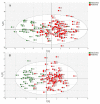Metabolomics Markers of COVID-19 Are Dependent on Collection Wave
- PMID: 36005585
- PMCID: PMC9415837
- DOI: 10.3390/metabo12080713
Metabolomics Markers of COVID-19 Are Dependent on Collection Wave
Abstract
The effect of COVID-19 infection on the human metabolome has been widely reported, but to date all such studies have focused on a single wave of infection. COVID-19 has generated numerous waves of disease with different clinical presentations, and therefore it is pertinent to explore whether metabolic disturbance changes accordingly, to gain a better understanding of its impact on host metabolism and enable better treatments. This work used a targeted metabolomics platform (Biocrates Life Sciences) to analyze the serum of 164 hospitalized patients, 123 with confirmed positive COVID-19 RT-PCR tests and 41 providing negative tests, across two waves of infection. Seven COVID-19-positive patients also provided longitudinal samples 2-7 months after infection. Changes to metabolites and lipids between positive and negative patients were found to be dependent on collection wave. A machine learning model identified six metabolites that were robust in diagnosing positive patients across both waves of infection: TG (22:1_32:5), TG (18:0_36:3), glutamic acid (Glu), glycolithocholic acid (GLCA), aspartic acid (Asp) and methionine sulfoxide (Met-SO), with an accuracy of 91%. Although some metabolites (TG (18:0_36:3) and Asp) returned to normal after infection, glutamic acid was still dysregulated in the longitudinal samples. This work demonstrates, for the first time, that metabolic dysregulation has partially changed over the course of the pandemic, reflecting changes in variants, clinical presentation and treatment regimes. It also shows that some metabolic changes are robust across waves, and these can differentiate COVID-19-positive individuals from controls in a hospital setting. This research also supports the hypothesis that some metabolic pathways are disrupted several months after COVID-19 infection.
Keywords: COVID-19; LC-MS; machine learning; targeted metabolomics.
Conflict of interest statement
The authors declare no conflict of interest.
Figures





Similar articles
-
Metabolic predictors of COVID-19 mortality and severity: a survival analysis.Front Immunol. 2024 May 10;15:1353903. doi: 10.3389/fimmu.2024.1353903. eCollection 2024. Front Immunol. 2024. PMID: 38799469 Free PMC article.
-
Metabolomics study of COVID-19 patients in four different clinical stages.Sci Rep. 2022 Jan 31;12(1):1650. doi: 10.1038/s41598-022-05667-0. Sci Rep. 2022. PMID: 35102215 Free PMC article.
-
Combining Semi-Targeted Metabolomics and Machine Learning to Identify Metabolic Alterations in the Serum and Urine of Hospitalized Patients with COVID-19.Biomolecules. 2023 Jan 12;13(1):163. doi: 10.3390/biom13010163. Biomolecules. 2023. PMID: 36671548 Free PMC article.
-
[Liquid chromatography-mass spectrometry-based metabolomics study of the efficacy of Chinese medicine asthma-relieving decoction on respiratory syncytial virus infection].Se Pu. 2021 Mar;39(3):281-290. doi: 10.3724/SP.J.1123.2020.06013. Se Pu. 2021. PMID: 34227309 Free PMC article. Chinese.
-
Metabolomics in the Diagnosis and Prognosis of COVID-19.Front Genet. 2021 Jul 23;12:721556. doi: 10.3389/fgene.2021.721556. eCollection 2021. Front Genet. 2021. PMID: 34367265 Free PMC article. Review.
Cited by
-
SARS-CoV2 variants differentially impact on the plasma metabolome.Metabolomics. 2025 Apr 5;21(2):50. doi: 10.1007/s11306-025-02238-y. Metabolomics. 2025. PMID: 40186806 Free PMC article.
-
Early Metabolomic and Immunologic Biomarkers as Prognostic Indicators for COVID-19.Metabolites. 2024 Jul 9;14(7):380. doi: 10.3390/metabo14070380. Metabolites. 2024. PMID: 39057703 Free PMC article.
-
Nucleotide, Phospholipid, and Kynurenine Metabolites Are Robustly Associated with COVID-19 Severity and Time of Plasma Sample Collection in a Prospective Cohort Study.Int J Mol Sci. 2023 Dec 26;25(1):346. doi: 10.3390/ijms25010346. Int J Mol Sci. 2023. PMID: 38203516 Free PMC article.
-
Multi-Omics Reveals Mechanisms of Partial Modulation of COVID-19 Dysregulation by Glucocorticoid Treatment.Int J Mol Sci. 2022 Oct 11;23(20):12079. doi: 10.3390/ijms232012079. Int J Mol Sci. 2022. PMID: 36292938 Free PMC article.
-
Metabolomic Insights into COVID-19 Severity: A Scoping Review.Metabolites. 2024 Nov 12;14(11):617. doi: 10.3390/metabo14110617. Metabolites. 2024. PMID: 39590853 Free PMC article.
References
-
- World Health Organization COVID-19 Weekly Epidemiological Update. [(accessed on 28 July 2022)]. Available online: https://www.who.int/publications/m/item/covid-19-weekly-epidemiological-....
-
- Almazeedi S., Al-Youha S., Jamal M.H., Al-Haddad M., Al-Muhaini A., Al-Ghimlas F., Al-Sabah S. Characteristics, risk factors and outcomes among the first consecutive 1096 patients diagnosed with COVID-19 in Kuwait. EClinicalMedicine. 2020;24:100448. doi: 10.1016/j.eclinm.2020.100448. - DOI - PMC - PubMed
Grants and funding
LinkOut - more resources
Full Text Sources
Miscellaneous

